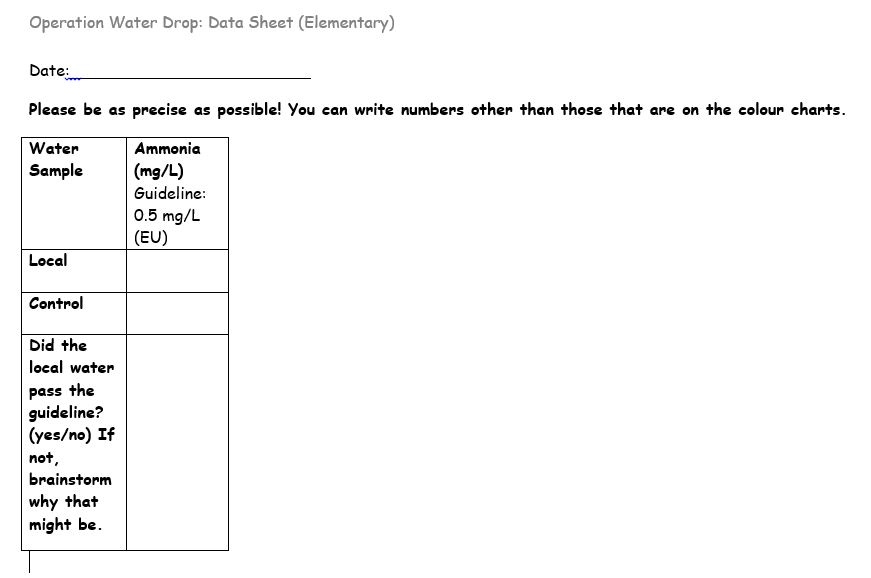Purpose: To determine the Ammonia concentration of a sample. Testing will be done on a Local Community Treated Water sample and a European Union limit sample for quality control purposes.
Determination will be done by using a test strip method. The major source of ammonia is runoff from fertilizers used in the farming community. The health risks are low, the major concern with ammonia is if the concentration is elevated then it will start to negate the effectiveness of the chlorination process as well as begin to form harmful Chloramines. A 0.5 mg/L standard is supplied for quality control purposes; this is also the limit that the European Union imposes.
Materials:
• 1 - Tube with 4 mL of 0.5 mg/L Ammonia European Union limit (AEUL)
• 2 - Test strips in a tube
• 1 - Colour chart for determining ammonia concentration
• 1 - Disposable beaker
Method:
Fill disposable beaker with Local Community Treated Water sample.
Dip ammonia test strip into water for five seconds, remove with pad face up and hold level for 60 seconds. Do not shake off excess water.
Compare the colour on the test strip to the colours on the colour chart after the 60 seconds have elapsed in order to determine the ammonia concentration.
Dip ammonia test strip into the 4 mL of AEUL in its vial for five seconds, remove with pad face up and hold level for 60 seconds. Do not shake off excess water.
Compare the colour on the test strip to the colours on the colour chart after the 60 seconds have elapsed in order to determine the ammonia concentration.
Write Your Results:
Results: Since there is no Canadian Drinking Water Guideline for Ammonia you will compare results to the European Union limit. The standard should give a result very close to 0.5 mg/L; if the colour is darker then it DOES NOT meet the guidelines.
Safe Handling of Materials Caution must be taken at all times when handling any chemicals. Although this test is safe to use in any area, please be cautious with the materials supplied.
Ammonium:
What is ammonia and why do we test our water for it?
Ammonium is a reduced form of nitrogen (NH4+) and together with the non-ionized form (NH3) they compose ammonia. Ammonia is frequently present in groundwater sources where there is no oxygen present. Ammonia ions play a key part in water treatment because they need to be removed before breakpoint chlorination can be achieved. Breakpoint needs to be reached to comply with Canada’s primary disinfection requirements.
Where does ammonia in water come from?
Ammonia comes from the breakdown of plants and animals, agricultural (application of large quantities of ammonia fertilizer), and industrial processes. The use of ammonia containing groundwater and chloramination can also contribute to the ammonia levels. Groundwater that is anaerobic (no oxygen) can contain large quantities of ammonia (>2 mg/L) while surface water sources generally contain levels ten times lower. During specific events in a lake, such as the death of an algal bloom, or spring and fall turnover (when bottom waters get mixed in with the surface water layer), the ammonia levels can increase although it is typically decreased quite rapidly. Also, intensive livestock operations can contribute large quantities of ammonia to surface water sources. High levels of ammonia in surface waters can therefore be an indicator of pollution by various sources.
Picture 1. Cattle grazing around a water source. What contaminants do you think will end up in the water under these circumstances? Do you think this is healthy for the cattle?
What are the current drinking water quality guidelines for ammonium?
There is no guideline for ammonia in the U.S. or Canada, but the European Union recommends that ammonia levels should be lower than 5 mg/L. However, as discussed here, such high levels would basically exclude the use of chlorine as a primary disinfectant. Unfortunately, many communities don’t realize this and are not adequately disinfecting their water.
What happens if ammonia levels are too high?
There are no health based guidelines for ammonia in drinking water, but its removal is recommended as ammonia can compromise disinfection, it can cause taste, odour and the formation of nitrite as well as interfering with the removal of manganese. Strong oxidizing reagents, such as ozone, chlorine dioxide, chloramines and potassium permanganate cannot remove ammonia ions while chlorine will remove the ammonia by forming less toxic compounds, the chloramines. However, for every mg of ammonia removed, the chlorine demand is 10-15 mg.
The use of chlorine for ammonia removal can only be recommended for water sources with less than 1 mg/L of ammonia (preferably less than 0.2 mg/L). If breakpoint chlorination is not achieved then the water treatment plant is using what is called secondary disinfection, which should only be used after primary disinfection has been carried out.
An ideal and inexpensive way of oxidizing the ammonia to nitrate is achieved by biological treatment where bacteria (nitrifiers) gain energy from the conversion of ammonia to nitrate. Initial problems of biologically removing ammonia at low temperatures (bacteria generally like warmer temperatures) have been overcome as shown by Yellow Quill First Nation where the oxidation of 4 mg/L of ammonium down to levels less than 0.05 mg/L is achieved at 6°C using a rapid filtration process (see www.safewater.org for more information on biological filtration).
What do I do if the level of ammonium in my water is too high?
We don’t recommend that action is taken in individual homes as these are issues that should be dealt with in the water treatment plant.



